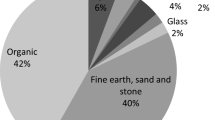Abstract
This paper discusses a property associated with plant biomass recalcitrance to enzyme and microbial deconstructions in sugar production from cellulose and hemicelluloses. The hemicelluloses are more readily hydrolyzed to sugars than is cellulose. As a result, optimization to maximize individual glucose and hemicellulose sugar recovery is not possible. This property is an inherent feature of plant biomass and is named polydispersity of plant biomass recalcitrance (PPBR) in this study. A set of pretreatment experiments using eucalyptus and sulfite pretreatment to overcome recalcitrance of lignocelluloses was conducted. The results were used to predict the conditions for individually maximizing enzymatic glucose and xylose yields. The predicted maximal yields were used to quantitatively illustrate the PPBR concept. The effect of PPBR on pretreatment optimization and strategies for maximal sugar recovery using two-stage pretreatment are discussed.




Similar content being viewed by others
References
Yang B, Wyman CE (2008) Pretreatment: the key to unlocking low-cost cellulosic ethanol. Biofuels, Bioprod Biorefin 2:26–40
Zhu JY, Pan XJ (2010) Woody biomass pretreatment for cellulosic ethanol production: technology and energy consumption evaluation. Bioresour Technol 101:4992–5002
Pan XJ, Gilkes N, Kadla J, Pye K, Saka S, Gregg D et al (2006) Bioconversion of hybrid poplar to ethanol and co-products using an organosolv fractionation process: optimization of process yields. Biotechnol Bioeng 94:851–861
Monavari S, Gable M, Zacchi G (2009) Impact of impregnation time and chip size on sugar yield in pretreatment of softwood for ethanol production. Bioresour Technol 100:6312–6316
Zhu JY, Pan XJ, Wang GS, Gleisner R (2009) Sulfite pretreatment (SPORL) for robust enzymatic saccharification of spruce and red pine. Bioresour Technol 100:2411–2418
Pan XJ, Xie D, Yu RW, Lam D, Saddler JN (2007) Pretreatment of lodgepole pine killed by mountain pine beetle using the ethanol organosolv process: fractionation and process optimization. Ind Eng Chem Res 46:2609–2617
Zhu YM, Lee YY, Elander RT (2005) Optimization of dilute-acid pretreatment of corn stover using a high-solids percolation reactor. Appl Biochem Biotechnol 121:1045–1054
Lee J-W, Rodrigues RCLB, Jeffries TW (2009) Simultaneous saccharification and ethanol fermentation of corn cob pretreated with oxalic acid using response surface methodology. Bioresour Technol 100:6307–6311
Murnen HK, Balan V, Chundawat SPS, Bals B, Sousa LDC, Dale BE (2007) Optimization of ammonia fiber expansion (AFEX) pretreatment and enzymatic hydrolysis of miscanthus x giganteus to fermentable sugars. Biotechnol Prog 23:846–850
Soderstrom J, Galbe M, Zacchi G (2004) Effects of washing on yield in one- and two-step steam pretreatment of softwood for production of ethanol. Biotechnol Prog 20:744–749
Yu Q, Zhuang X, Yuan Z, Wang Q, Qia W, Wang W et al (2010) Two-step liquid hot water pretreatment of Eucalyptus grandis to enhance sugar recovery and enzymatic digestibility of cellulose. Bioresour Technol 101:4895–4899
Fonseca CM, Fleming PJ (1995) An overview of evolutionary algorithms in multiobjective optimization. Evol Comput 3:1–16
Van Vleet JH, Jeffries TW (2009) Yeast metabolic engineering for hemicellulosic ethanolproduction. Curr Opin Biotechnol 29:300–306
Zhu W, Zhu JY, Gleisner R, Pan XJ (2010) On energy consumption for size-reduction and yield from subsequent enzymatic sacchrification of pretreated lodgepole pine. Bioresour Technol 101:2782–2792
Wang GS, Pan XJ, Zhu JY, Gleisner R (2009) Sulfite pretreatment to overcome recalcitrance of lignocellulose (SPORL) for robust enzymatic saccharification of hardwoods. Biotechnol Prog 25:1086–1093
Tian S, Zhu W, Gleisner R, Pan XJ, Zhu JY (2011) Comparisons of SPORL and Dilute Acid Pretreatments for Sugar and Ethanol Productions from Aspen. Biotechnology Progress (in press) doi:10.1002/btpr.545
Zhu JY, Zhu W, OBryan P, Dien BS, Tian S, Gleisner R et al (2010) Ethanol production from SPORL-pretreated lodgepole pine: preliminary evaluation of mass balance and process energy efficiency. Appl Microbiol Biotechnol 86:1355–1365
Davis MW (1998) A rapid modified method for compositional carbohydrate analysis of lignocellulosics by high pH anion-exchange chromatography with pulsed amperometric detection (HPAEC/PAD). J Wood Chem Technol 18:235–252
Shuai L, Yang Q, Zhu JY, Lu F, Weimer P, Ralph J et al (2010) Comparative study of SPORL and dilute acid pretreatments of softwood spruce for cellulose ethanol production. Bioresour Technol 101:3106–3114
Monavari S, Bennato A, Galbe M, Zacchi G (2010) Improved one-step steam pretreatment of So2-impregnated softwood with time-dependent temperature profile for ethanol production. Biotechnol Prog 26:1054–1060
Acknowledgments
We especially appreciate Fred Matt (US Forest Service, Forest Products laboratory) for carrying out many careful analyses of carbohydrate in solid substrates. Financial support of this research included the University of Florida IFAS Research Innovation Fund and The US Forest Service Program of Woody Biomass, Bioenergy, and Bioproducts (2009). These programs and the Chinese Scholarship Council provided financial support to Liu for his visiting appointments at the University of Wisconsin-Madison and the US Forest Service, Forest Products laboratory.
Author information
Authors and Affiliations
Corresponding author
Additional information
This work was conducted on official US government time by Zhu, Verrill, and Herian, while Liu was a visiting student at the University of Wisconsin-Madison and USDA Forest Service, Forest Products Laboratory. The work is in the public domain in the USA.
Rights and permissions
About this article
Cite this article
Zhu, J.Y., Verrill, S.P., Liu, H. et al. On Polydispersity of Plant Biomass Recalcitrance and Its Effects on Pretreatment Optimization for Sugar Production. Bioenerg. Res. 4, 201–210 (2011). https://doi.org/10.1007/s12155-011-9113-y
Published:
Issue Date:
DOI: https://doi.org/10.1007/s12155-011-9113-y




